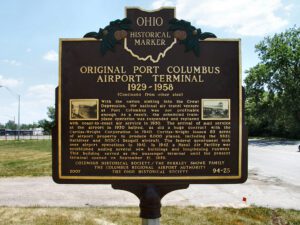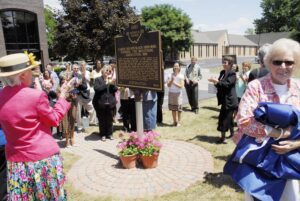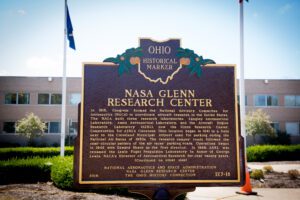, OH
The original Port Columbus Airport terminal was founded by the people of Columbus and was one of the first airport facilities in the United States. Dedicated on July 8, 1929, Port Columbus was the first transfer point in the westbound transcontinental passenger service, which was operated by the Pennsylvania Railroad, Transcontinental Air Transport (TAT), and the Santa Fe Railway. Its first passengers departed by rail from New York City on July 7, 1929, and boarded TAT Ford Tri-Motor aircraft at Port Columbus to fly to Waynoka, Oklahoma, the following day. They then traveled by rail to Clovis, New Mexico, and completed their journey with a TAT flight to Los Angeles. The scheduled 48-hour trip was celebrated in Columbus, marking the beginning milestone of national airport travel. (continued on other side)
, OH
The Breathing Association was founded in 1906 as the Tuberculosis Society under the leadership of public health advocate Carrie Nelson Black. The society provided nutrition, medical care, and sanitorium services to people who could not afford proper medical care. A tuberculosis dispensary was operated at 40 South Third Street in Columbus for Ohioans needing consultation and treatment. Tuberculosis, known as the White Plague, killed one out of nine persons in Columbus during the early 1900s. An Open Air School was established on Neil Avenue in 1913 for children in homes where there were one or more cases of tuberculosis. In 1931, the Nightingale Cottage was opened on Brice Road as a tuberculosis preventorium for children. As tuberculosis became controllable, the agency became focused on emerging lung health issues. Today, The Breathing Association continues as a leading resource on lung health issues and preventing lung disease.
, OH
In 1915, Congress formed the National Advisory Committee for Aeronautics (NACA) to coordinate aircraft research in the United States. The NACA built three research laboratories: Langley Aeronautical Laboratory, Ames Aeronautical Laboratory, and the Aircraft Engine Research Laboratory (AERL), now the Glenn Research Center. Construction for AERL’s Cleveland, Ohio location began in 1941 in a field next to the Cleveland Municipal Airport used for parking during the National Air Races of the 1930s. The research campus’ roads followed the semi-circular pattern of the air races’ parking roads. Operations began in 1942 with Edward Sharp as the first director. In 1948, AERL was renamed the Lewis Flight Propulsion Laboratory in honor of George Lewis, NACA’s Director of Aeronautical Research for over twenty years.




